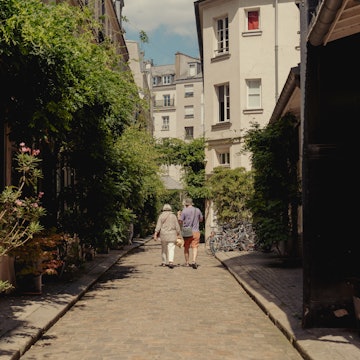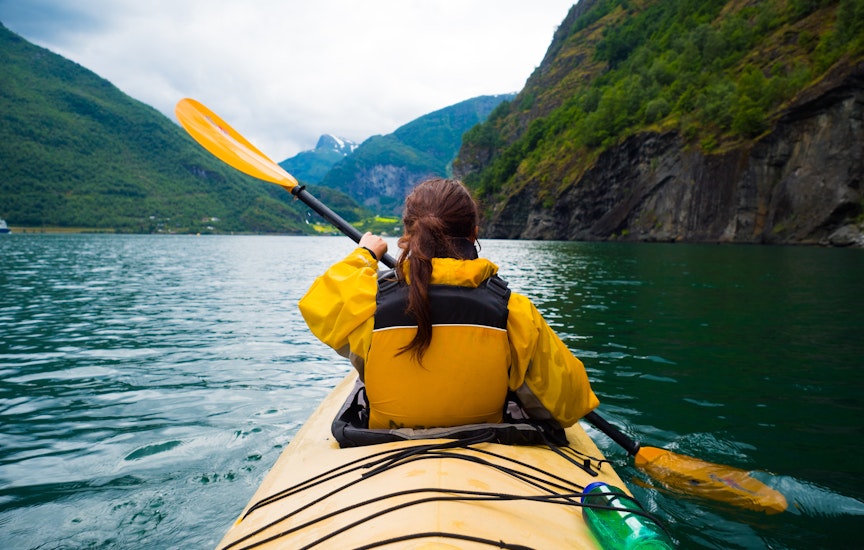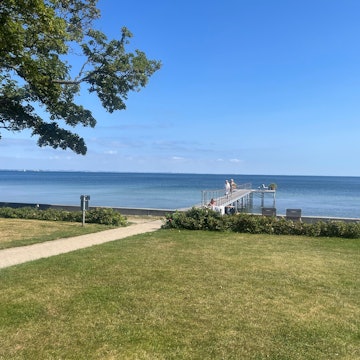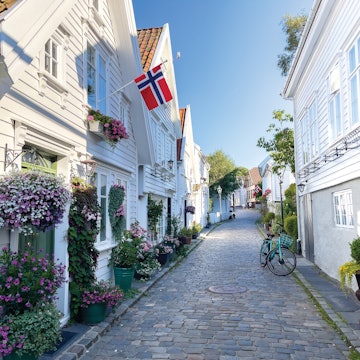

The Oslo Opera House in summer. S-F/Shutterstock
A two-decade-long glow-up to the area around Oslo's harbor catapulted Norway’s premier city into a bona fide culture capital. Exceptional museums covering art, maritime exploration and ancient and modern history are complemented by award-winning architecture, sprawling sculpture parks and intriguing islands that are completely free to explore. And that redevelopment just adds to the city's already grand buildings, subversive artistic undercurrent and unfettered access to pristine nature, plus a packed 2025 event schedule and varied culinary scene.
Settle in for a city break that has it all and make the most of your first trip to Oslo with this guide to when to go, what to see and how much it will cost.

When should I go to Oslo?
June, July and August are the peak months for domestic and international travelers. Daylight lingers well into the evenings, and temperatures are reliably pleasant, hovering around 20°C (68°F). But don’t be surprised by a run of days exceeding 30°C (86°F). Expect the harbor baths and city beaches to be packed with locals making the most of every last ray of sunshine, and prepare to get to museums early to avoid the worst of the high-season crowds. Summer also sees major festivals and events across the city, including OverOslo and Pride in June, Øya Festival in August and By:Larm in September. Room rates soar over festival dates, so book as far in advance as possible.
Though slightly cooler, the weather is usually still good during May and September, and these shoulder months are ideal if you want to snag lower room rates and avoid the masses. The exception to this is May 17, when the whole city turns out in national dress to celebrate Constitution Day, with huge parades, marching bands and bucketloads of ice cream. It’s an especially joyful time to be in Oslo, but attractions and almost all of the shops will be closed on the day, and dinner reservations are essential.
Days grow short and cold during autumn and winter – commonly -5 to 0°C (23 to 32°F) in January and February – but you’ll find ice-skating rinks in the city center and have the chance to ski the runs at Skimore Oslo, reachable on the T-Bane. Prefer to watch the pros? Visit in March to see elite ski jumpers, biathletes and cross-country skiers compete during the Holmenkollen Ski Festival.

How much time should I spend in Oslo?
With two days, you can comfortably cover some big hitters. Factor in time to see the Nasjonalgalleriet for a whistle-stop tour of Norway’s finest artistic treasures; the Munch Museum to understand the man behind The Scream; the Royal Palace, home of the Norwegian royals; and Vigelandsparken to see Gustav Vigeland’s expressive sculptures. And don’t miss a stroll on top of the Oslo Opera House. Between the culture, squeeze in time for vintage shopping in Grünerløkka and perusing the food vendors at Mathallen Oslo, the city’s original and best food hall, then wind up at Blå for live music.
With four days, you can see more of the city’s natural surroundings. One day might involve taking the Bygdøy ferry (or the number 30 bus) to the Bygdøy peninsula. You could drop into any of the museums there (Norsk Folkemuseum, Polarship Fram Museum, Kon-Tiki Museum and Norwegian Maritime Museum) or ignore them completely and make a beeline for the Huk or Paradisbukta beaches, tucked away along forested trails beyond the neighborhood’s attractive villas. Another day, pack a picnic and take the B1 or B2 ferry to the islands in the Oslofjord – Hovedøya has a ruined Cistercian monastery, Gressholmen has a nature preserve and rustic cafe, and Langøyene has a beach and campground.

Is it easy to get in and around Oslo?
Oslo Gardermoen Airport, around 50km (31 miles) north of the city, is served by all major airlines and many budget operators, including EasyJet and Norwegian. Getting into the city center couldn’t be easier: trains run direct to Oslo S – the city’s main train station – from right outside the arrivals hall. Choose between the more expensive Flytoget express train, which costs 252kr (US$25) and runs every 10 minutes, or the regular Vy trains; there are only three Vy trains an hour, but tickets are far cheaper, at 129kr (US$13). Flytoget is marginally faster, but both options take around 20 minutes. Some budget airlines fly to Torp Sandefjord Airport, over 100km (62 miles) southwest of Oslo, but the slightly lower airfares are rarely worth the inconvenience.
If you want to avoid flying, you can reach Oslo by DFDS ferry from Copenhagen or Fredrikshavn in Denmark, or by train from Gothenburg in Sweden.
Once in the center of town, you'll find that Oslo is quite compact, and many of its biggest attractions are within easy walking distance of each other. To get from A to B more quickly, there’s an extensive, easy-to-navigate public transportation system, with trams, buses, a metro and ferries. The six-line tram service runs from around 5:30am to 1am; tram 12 is especially useful as it stops very close to many major sights, including Vigelandsparken, the Nasjonalgalleriet, Rådhus, Akershus Festning and the Oslo Opera House, before gliding up to the ever popular Grünerløkka neighborhood.
The city’s buses fill in the gaps not covered by trams, and they run 24 hours a day, though there are fewer services overnight. The T-Bane, Oslo's metro system, has five lines that snake out to the suburbs, and all serve Jernbanetorget (for Oslo S) and the National Theater. A fleet of electric ferries zip from Aker Brygge to the islands in the Oslofjord and beyond; services are most frequent in summertime.
The whole network is operated by Ruter, and tickets are valid across all services. Oslo city is covered by a Zone 1 ticket; tickets are sold as singles for 44kr (US$4), 24-hour passes for 132kr (US$13) and seven-day passes for 366kr (US$36). The easiest way to plan your journey and buy tickets is via the Ruter app, but you can buy paper tickets at T-Bane ticket machines as well as 7-Eleven and Narvesen stores or from the Ruter Customer Service Center on Jernbanetorget. Note that Ruter tickets aren’t valid on the Bydgøy ferry.

Top things to do in Oslo
Sweat in a floating sauna
No matter if you’re visiting in the height of summer or the depth of winter, a session in one of Oslo’s floating saunas – including a plunge in the Oslofjord to cool off – is an exhilarating way to spend an hour or so. You’ll see them at Aker Brygge and on Langkaia near the opera house, but the ones run by Oslo Badstuforening at Sukkerbiten (close to the Munch Museum) are the most secluded.
Climb the slope of the Oslo Opera House
Yes, everyone does it, but walking up the roof of the iceberglike Oslo Opera House to gaze across the fjord at sundown is an Oslo rite of passage. Designed by homegrown architects Snøhetta, the white marble marvel was inaugurated in 2008 and has invited people to stand atop its gleaming expanse ever since.

See larger-than-life sculptures at Vigelandsparken
Hundreds of figurative works by the renowned Norwegian sculptor Gustav Vigeland (1869–1943) are laid out in this beautifully landscaped sculpture park inside Frognerparken, on Oslo’s upscale west side. All works lead toward the 17m (16ft) Monolitten (Monolith), a granite tower of writhing bodies surrounded by 36 clusters of poignantly posed figures.
Walk the Akerselva
This river literally powered Oslo’s textile factories in the 19th century, and ambling along at least some of its 9km (6-mile) course will give you insight into the city’s industrial heritage. Join the river at Grønland and you’ll pass its landmarks, including a former indigo factory that now hosts the music venue Blå and a makers’ market on Sundays, as well as a one-time sail factory that’s been converted into the Oslo National Academy of the Arts and the Labor Museum, which tells the workers' story.
My favorite thing to do in Oslo
When the sun is shining, there’s nothing better than taking the T-Bane line 1 all the way to Frognerseteren and heading out on the well-marked trails through the Nordmarka forest. It’s so close to the city center, yet it’s still mostly locals hiking here. A brisk walk in the spruce-scented air is the perfect way to relax. Before returning to the center, I’ll stop at Kafé Seterstua, located inside Frognerseteren (the 19th-century wooden chalet that the T-Bane stop is named for) and have a coffee and a wedge of apple cake.

How much money do I need for Oslo?
There are countless reasons to get excited about a trip to Oslo, but one factor could make or break your vacation: the cost. Norway is an expensive country – even compared to its Nordic neighbors – and its capital is no exception. While the standard of accommodations in the city is generally high, you won’t get as much room for your money as in other European countries. Aside from accommodations, your greatest expense is likely to be eating out and, if you drink alcohol, the cost of your favorite tipple (yes, it really does cost as much as you’ve heard).
To stretch your budget, consider having your main meal at lunch – restaurants often offer lunch specials that are a good value – and if you want to have a big night out, do as the locals do and stock up at the nearest Vinmonopolet (government-run alcohol store) for forspill (pre-drinks).
If you’re a museum lover and plan to max out on culture during your visit, an Oslo Pass could save you serious cash. As well as giving you free entry to almost every attraction in the city, the pass includes all public transportation for the duration of the pass (including the ferry to the Bygdøy museums). Tally the figures for your itinerary, though – you’d typically have to visit three attractions and make three public transport journeys to make a 550kr (US$55) 24-hour pass cost effective; the 72-hour pass offers the greatest value, working out to just over 300kr (US$30) per day.
But you can actually experience Oslo’s charms without spending any money at all: catch the daily changing of the guard outside the Royal Palace; meander along the harbor promenade; walk the length of the Akerselva; hike in the forest; swim in the harbor baths; and take yourself on an art trail through one of the city’s world-class sculpture parks – all for free.
Night in a dorm: 450kr (US$45)
Night in a midrange hotel: from 1500kr (US$149)
Night in a self-catering apartment: from 1300kr (US$129)
Munch Museum ticket: 180kr (US$18)
Oslo Pass (24, 48 or 72 hours): 550, 800 or 945kr (US$55, US$79 or US$94)
Filter coffee: 40kr (US$4)
Sandwich: 100–150kr (US$10–15)
Two-course dinner for two: from 1000kr (US$99)
0.25L (8.5oz) draft beer: 75kr (US$7)
Harbor sauna session: from 220kr (US$22)
Is it better to pay by cash or card?
While cash is widely accepted in Oslo, shops, restaurants, bars and cafes generally prefer debit or credit card payments, even for small transactions. Paying by card is sometimes the only option, however. Some casual restaurants take a “scan the barcode to order and pay at once” approach, transportation apps will require a payment card, and a small number of places don’t accept cash at all.
You’ll also see some market vendors (and even some vending machines) requesting payment by Vipps, a peer-to-peer payment app. Unfortunately, it only works with a Norwegian bank account, so before you buy, ask if they’ll accept an alternative payment method.
How much should I tip?
Tips will be gratefully accepted, but there isn’t a huge culture of tipping in Norway and it’s never expected. If you’ve received great service in a restaurant or bar and you’d like to show your appreciation, a tip of 5% to 15% is appropriate.















